A federal court could rule soon whether the removal of a student's painting from the U.S. Capitol violated the artist's First Amendment rights.
Outside art experts and the speaker of the U.S. House of Representatives were part of deliberations into the removal of the high school student's controversial painting from U.S. Capitol grounds in January, according to court filings.
The filings were part of more than 100 pages of documents provided by the architect of the Capitol to justify his decision to remove "Untitled #1," an acrylic painting depicting police officers as animals brandishing firearms.
The painting's removal stirred a raging dispute on Capitol Hill earlier this year. It was removed multiple times, without permission, by members of Congress and rehung by Rep. William Lacy Clay (D-Mo.), who represents the district in which the student painter lives.
The architect of the Capitol, who oversees the high school art competition in which the painting was submitted, ended the dispute by ruling the painting formally removed. His decision sparked a federal lawsuit by Clay and the student painter against the Office of the Architect of the Capitol.
[NATL] Top News Photos: Pope Visits Japan, and More
Local
Washington, D.C., Maryland and Virginia local news, events and information
In court filings defending his decision, Architect of the Capitol Stephen Ayers reveals he "informally conferred" with an acting provost of the Smithsonian Institution and the director of the American Folk Art Museum before determining the painting failed to comply with guidelines for the high school art competition.
"The architect and these experts came to the consensus that 'Untitled #1' did not meet the competition's suitability guidelines," Ayers said in his filings.
U.S. House leaders were asked to formally vote to support the painting's removal, Ayers said in his filings to the judge. The U.S. House Building Commission, which consists of House Speaker Paul Ryan, Majority Leader Kevin McCarthy and Minority Leader Nancy Pelosi, voted in February to uphold his decision, Ayers said.
Ayers argued paintings chosen as winners in the congressional high school art competition do not enjoy full First Amendment free speech rights.
"On the contrary, the art display on government walls on a tunnel between the Capitol and the House Office Building constitutes government speech," he said. "The fact that this display was created through a Congressional Art Competition involving private parties -- a competition which the government designed, sponsored and controlled -- does not alter this conclusion."
The I-Team's review of court records shows U.S. House administrators last removed a high school art competition work in 1989. In that case, the art piece chosen by a Cleveland-area member of the U.S. House was later found to have been a copy of a professional photograph featured in an April 1989 issue of Vogue magazine.

In his court filings, Ayers said his office received no other complaints about any other art pieces in the 2016 competition besides the removals and protests over "Untitled #1."
Clay and Rep. Jamie Raskin (D-Md.) sent a letter to Ayers asking he return the painting to its position in the Cannon House Office Building tunnel.
"In America, we don't arrest artwork," the congressmen said in their letter.
The high school student's painting "appears to be influenced by Picasso's violent dreamscape in 'Guernica' and George Orwell's dystopian parable 'Animal Farm,'" they said.
The congressional high school art competition was launched in October 1981 by former U.S. House Speaker Tip O'Neill. In a letter authorizing the project, O'Neill said, "The tunnels could benefit from aesthetic enlivenment," according to congressional records reviewed by the I-Team.




